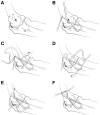Elbow Ulnar Collateral Ligament Reconstruction Using the Novel Docking Plus Technique in 324 Athletes
- PMID: 30649654
- PMCID: PMC6335231
- DOI: 10.1186/s40798-018-0174-8
Elbow Ulnar Collateral Ligament Reconstruction Using the Novel Docking Plus Technique in 324 Athletes
Abstract
Background: This retrospective case series examined 324 athletes who received elbow ulnar collateral ligament (UCL) reconstruction by a single surgeon in a private practice over a 9-year period. The novel Docking Plus technique for elbow UCL reconstruction in 324 athletes provided good or excellent Conway score results in 88% of patients. The preponderance of previous studies examining UCL reconstruction outcomes were performed by surgeons at one of only three institutions (Andrews Institute, Hospital for Special Surgery, Kerlan Jobe Orthopedic Clinic).
Methods: Patients undergoing UCL reconstruction from November 2005 to December 2014 were identified and contacted with a mailed survey and phone call. These patients were given a subjective 19 question survey assessing their outcomes from surgery.
Results: The participants who responded to our survey were 90% male and 77% baseball players, 73% of which were pitchers. Of the baseball players who responded, 51.9% were in high school at the time of their surgery, 37% college, 6.5% minor leagues, and 2.2% in Major League Baseball. After surgery, 36% of survey responders returned to a higher level of competition than previously. For example, a high school athlete who had UCL reconstruction and went on to pitch in college. Further, 45% returned to the same level, and 7% returned to a lower level. Subjective "satisfaction," was reported in 92% of responders and 97.2% reported that, "having surgery was a good idea." Symptom onset in the responding athletes was 58.9% sudden, and 41.1% gradual. Overall, 90.9% of respondents returned to play in less than 1.5 years while 6.3% never were able to return. Re-tear occurred in 2.5% of patients, while 8.8% had subjective nerve dysfunction for at least 3 months following surgery.
Conclusion: The Docking Plus technique can produce excellent subjective and objective results in athletes. Further study is warranted to see the effects of this procedure in other settings and determine which method of reconstruction or repair is superior.
Keywords: Baseball; Elbow; Ligament reconstruction; Tommy John Surgery; UCL.
Conflict of interest statement
Ethics Approval and Consent to Participate
Our study was determined to be IRB exempt as it was an anonymous survey. ShulmanIRB # 201607774.
Consent for Publication
No individual person’s data is present.
Competing Interests
The authors, Benjamin Donohue, Marc Lubitz, and Timothy Kremchek, declare that they have no competing interests.
Publisher’s Note
Springer Nature remains neutral with regard to jurisdictional claims in published maps and institutional affiliations.
Figures







Similar articles
-
Outcomes After Ulnar Collateral Ligament Revision Reconstruction in Baseball Players.Am J Sports Med. 2020 Nov;48(13):3359-3364. doi: 10.1177/0363546520951529. Epub 2020 Oct 21. Am J Sports Med. 2020. PMID: 33085494
-
Outcomes following arthroscopic posteromedial osteophyte resection and risk of future ulnar collateral ligament reconstruction.J Shoulder Elbow Surg. 2023 Jan;32(1):141-149. doi: 10.1016/j.jse.2022.08.002. Epub 2022 Sep 24. J Shoulder Elbow Surg. 2023. PMID: 36167288
-
Clinical Outcomes of Ulnar Collateral Ligament Surgery in Nonthrowing Athletes.Am J Sports Med. 2022 Oct;50(12):3368-3373. doi: 10.1177/03635465221120654. Epub 2022 Sep 13. Am J Sports Med. 2022. PMID: 36112993
-
Ulnar Collateral Ligament Reconstruction in Adolescents: A Systematic Review.Am J Sports Med. 2021 Apr;49(5):1355-1362. doi: 10.1177/0363546520934778. Epub 2020 Aug 13. Am J Sports Med. 2021. PMID: 32791013
-
Modified Jobe Versus Docking Technique for Elbow Ulnar Collateral Ligament Reconstruction: A Systematic Review and Meta-analysis of Clinical Outcomes.Am J Sports Med. 2021 Jan;49(1):236-248. doi: 10.1177/0363546520921160. Epub 2020 Jun 29. Am J Sports Med. 2021. PMID: 32598852
Cited by
-
Return-to-Sport Criteria After Upper Extremity Surgery in Athletes-A Scoping Review, Part 2: Ulnar Collateral Ligament of the Elbow Procedures.Orthop J Sports Med. 2021 Aug 7;9(8):23259671211021825. doi: 10.1177/23259671211021825. eCollection 2021 Aug. Orthop J Sports Med. 2021. PMID: 34395685 Free PMC article.
-
Comparison of Ulnar Collateral Ligament Reconstruction Techniques in the Elbow of Sports Players.Clin Shoulder Elb. 2020 Feb 28;23(1):41-47. doi: 10.5397/cise.2019.00171. eCollection 2020 Mar. Clin Shoulder Elb. 2020. PMID: 33330233 Free PMC article. Review.
-
The History and Evolution of Elbow Medial Ulnar Collateral Ligament Reconstruction: from Tommy John to 2020.Curr Rev Musculoskelet Med. 2020 Jun;13(3):349-360. doi: 10.1007/s12178-020-09618-y. Curr Rev Musculoskelet Med. 2020. PMID: 32314245 Free PMC article. Review.
-
UCL Injury in the Non-throwing Athlete.Curr Rev Musculoskelet Med. 2019 Dec;12(4):527-533. doi: 10.1007/s12178-019-09590-2. Curr Rev Musculoskelet Med. 2019. PMID: 31755025 Free PMC article. Review.
-
Rehabilitation Protocols in Elbow Medial Ulnar Collateral Ligament Injuries: A Systematic Review of Articles Published in the Last 20 Years.Sports Health. 2025 May-Jun;17(3):460-469. doi: 10.1177/19417381241249125. Epub 2024 May 3. Sports Health. 2025. PMID: 38702939 Free PMC article.
References
-
- Ahmad CS. Treatment of medial collateral ligament injuries of the elbow with use of the “Tommy John” operation: indications and results. JBJS Rev. 2014;2(6):1–9. - PubMed
LinkOut - more resources
Full Text Sources
Miscellaneous

